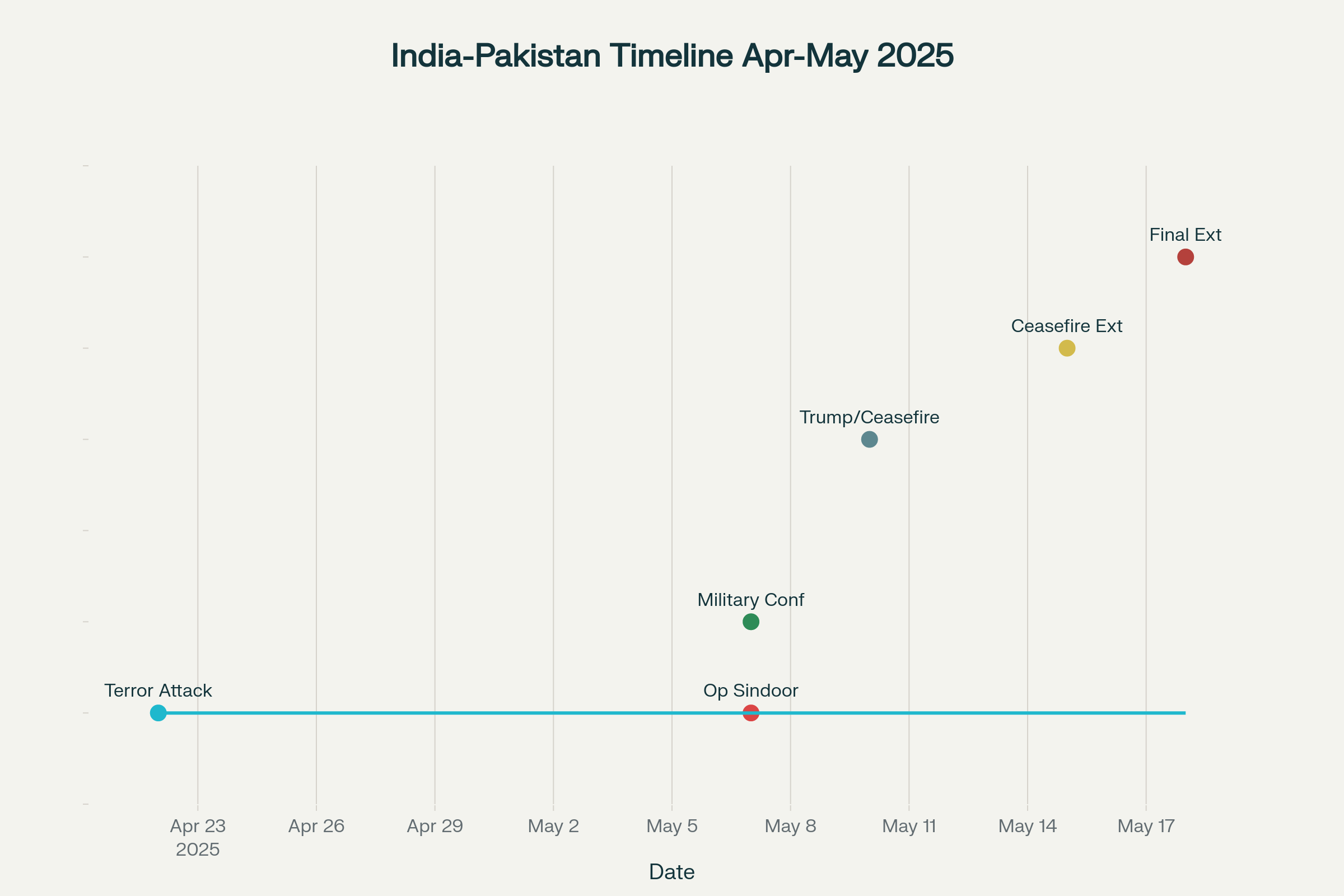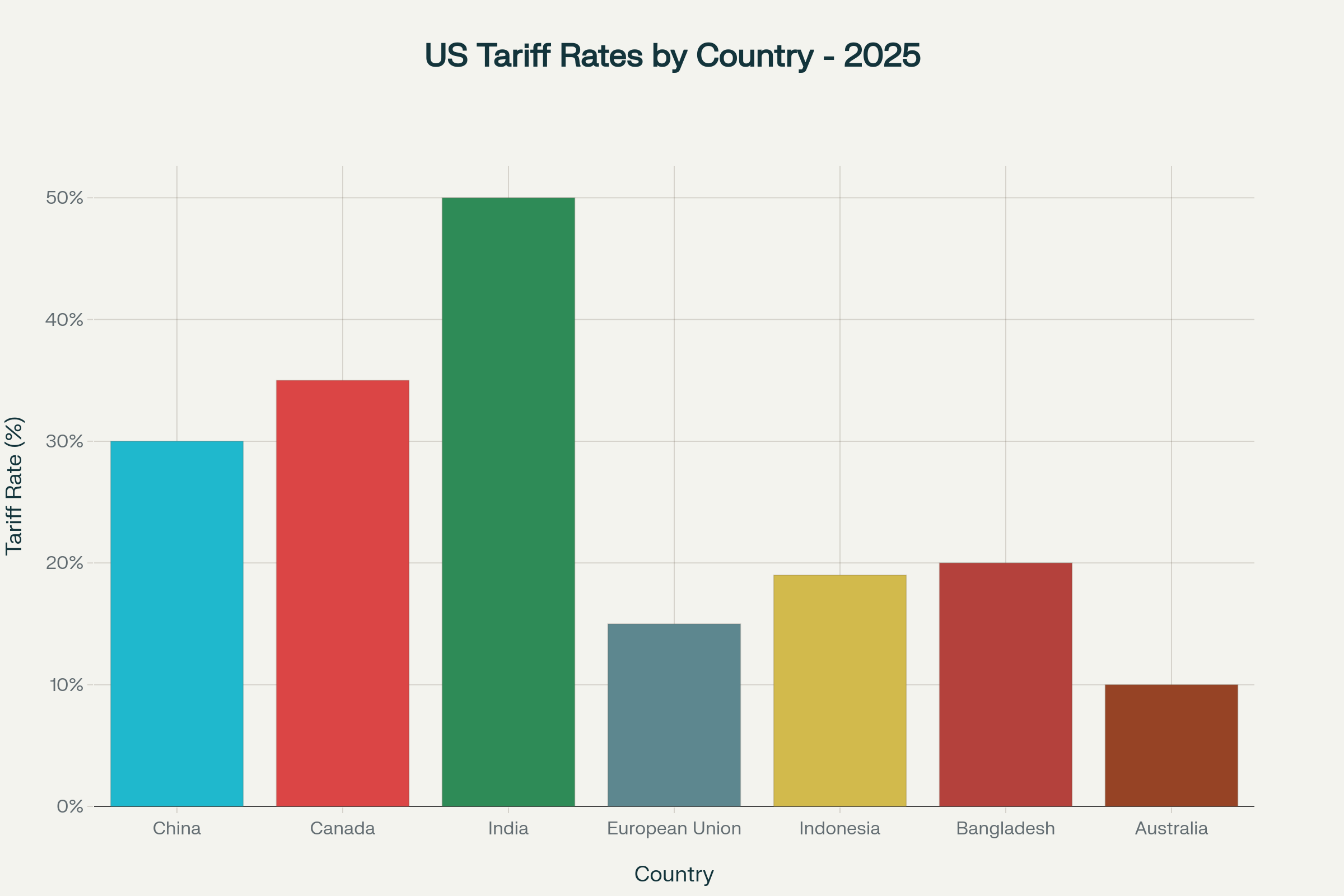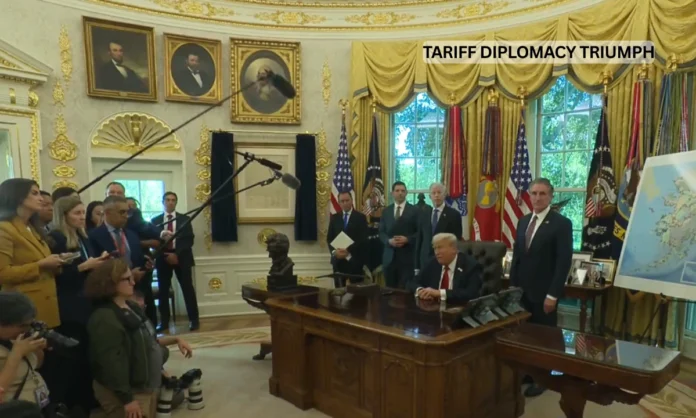Key Highlights:
- Trump asserts his tariff threats directly resulted in the Trump tariffs India Pakistan ceasefire agreement on May 10, 2025
- Pakistan nominated Trump for Nobel Peace Prize citing his role in the Trump tariffs India Pakistan ceasefire diplomacy
- India disputes US mediation claims, maintaining the Trump tariffs India Pakistan ceasefire was achieved through bilateral military communications
US President Donald Trump has repeatedly claimed that his administration’s aggressive tariff strategy was instrumental in achieving the Trump tariffs India Pakistan ceasefire following the May 2025 military conflict between the nuclear-armed neighbors. Speaking to reporters at the White House on October 6, Trump emphasized that America serves as a “peacekeeper because of tariffs,” directly linking his economic policies to the Trump tariffs India Pakistan ceasefire resolution. The President’s assertions about the Trump tariffs India Pakistan ceasefire have become a central narrative in his foreign policy achievements, despite India’s consistent denial of any US mediation role in the bilateral military resolution.
President Trump Delivers Remarks https://t.co/SuBd7yBcJE
— The White House (@WhiteHouse) October 6, 2025
The conflict that preceded the Trump tariffs India Pakistan ceasefire erupted following the April 22 Pahalgam terrorist attack that killed 26 civilians, prompting India to launch Operation Sindoor targeting terrorist infrastructure in Pakistan and Pakistan-occupied Kashmir. Trump’s claims about orchestrating the Trump tariffs India Pakistan ceasefire through economic pressure have generated significant diplomatic controversy, with Indian officials maintaining that the resolution resulted from direct military-to-military communications without external intervention. The Trump tariffs India Pakistan ceasefire narrative has been further complicated by Pakistan’s decision to nominate Trump for the 2026 Nobel Peace Prize, creating divergent international perspectives on the role of US economic diplomacy in South Asian conflict resolution.

Timeline of the 2025 India-Pakistan Crisis and Trump’s Claimed Mediation Role
Military Crisis Context Behind Trump Tariffs on India Pakistan Ceasefire Claims
- Operation Sindoor targeted nine terrorist training camps across Pakistan and Pakistan-occupied Kashmir during May 7-8, 2025
- The four-day conflict featured unprecedented drone warfare between both nations before the Trump tariffs India Pakistan ceasefire
- More than 50 casualties occurred during the crisis, primarily along the Line of Control in Kashmir
The events leading to the Trump tariffs India Pakistan ceasefire began with the devastating Pahalgam attack on April 22, 2025, when Pakistan-based terrorist group “The Resistance Front” killed 26 tourists after segregating them based on religion. India’s response came through Operation Sindoor, a precision military campaign launched on May 7-8, 2025, targeting terrorist infrastructure across nine locations in Pakistan and Pakistan-occupied Kashmir. This operation was deliberately designed as non-escalatory, focusing exclusively on terrorist camps rather than military installations to avoid triggering the broader conflict that would later influence Trump’s narrative about the Trump tariffs India Pakistan ceasefire.
Pakistan escalated the situation by launching coordinated drone and missile strikes against over a dozen Indian military installations across northern and western theaters, including facilities in Srinagar, Jammu, and Pathankot. The conflict that preceded the Trump tariffs on India Pakistan ceasefire witnessed unprecedented drone warfare between the two nuclear-armed nations, marking a significant evolution in South Asian military tactics. India’s integrated counter-drone systems successfully intercepted these attacks, while Indian forces responded with precision strikes against Pakistani air defense systems, creating the high-stakes environment that Trump claims necessitated his intervention in the Trump tariffs India Pakistan ceasefire.
According to the Stimson Center, more than 50 casualties occurred during the four-day crisis that ended with the Trump tariffs India Pakistan ceasefire, primarily along the Line of Control in Kashmir, with civilian areas bearing significant impact from Pakistani mortar and artillery fire. The Trump tariffs India Pakistan ceasefire was officially established on May 10, 2025, at 17:00 hours Indian Standard Time following direct communication between the Directors General of Military Operations of both countries. Despite Trump’s repeated claims about orchestrating the Trump tariffs India Pakistan ceasefire through economic pressure, Indian sources consistently emphasize the bilateral nature of the military-to-military resolution without external mediation.
US Tariff Policy and Economic Pressure Strategy
| Trade Indicator | FY 2023-24 | FY 2024-25 | Growth Rate |
|---|---|---|---|
| India’s Exports to US | $77.52 billion | $86.51 billion | +11.6% |
| India’s Imports from US | $42.20 billion | $45.33 billion | +7.44% |
| Total Bilateral Trade | $119.72 billion | $131.84 billion | +10.13% |
| India’s Trade Surplus | $35.32 billion | $41.18 billion | +16.59% |
Trump’s assertions about the Trump tariffs India Pakistan ceasefire reflect his broader economic diplomacy strategy, which has seen unprecedented escalation against India throughout 2025. The United States currently imposes a 50% total tariff rate on most Indian goods, representing the highest tariff burden among major US trading partners and forming the economic foundation for Trump’s claims about the Trump tariffs India Pakistan ceasefire. This tariff rate exceeds those imposed on China (30%), Canada (35%), and the European Union (15%), demonstrating the specific economic pressure that Trump alleges influenced the Trump tariffs India Pakistan ceasefire negotiations.
The bilateral trade relationship that underlies the Trump tariffs India Pakistan ceasefire narrative totaled $131.84 billion in FY 2024-25, with India maintaining a significant trade surplus of $41.18 billion. According to official trade data, India’s exports to the United States reached $86.51 billion in FY 2024-25, representing an 11.6% increase from the previous year despite the tariff pressures that Trump claims were instrumental in the Trump tariffs India Pakistan ceasefire. The US Census Bureau reports that America imported goods worth $45.33 billion from India in FY 2024-25, while maintaining its position as India’s largest trading partner.

US Tariff Rates by Major Trading Partners in 2025
The escalating tariff regime that Trump connects to the Trump tariffs India Pakistan ceasefire includes a 50% total rate implemented through baseline duties, reciprocal tariffs announced in April 2025, and additional penalties effective August 27, 2025. Indian sectors most affected by these tariffs include textiles, gems and jewelry, leather goods, marine products, chemicals, and automotive components, with 55% of India’s US-bound exports facing significant exposure. Trump has announced additional tariff measures, including a 25% duty on medium and heavy-duty truck imports starting November 1, 2025, demonstrating the continuing escalation of his trade policy that he claims enabled the Trump tariffs India Pakistan ceasefire.
Pakistan’s Nobel Prize Nomination and International Recognition
- Pakistan formally nominated Trump for 2026 Nobel Peace Prize on June 21, 2025, citing his role in the Trump tariffs India Pakistan ceasefire
- The nomination specifically credits Trump’s “decisive diplomatic intervention” during the crisis resolution
- 338 candidates have been nominated for the 2025 Nobel Peace Prize, with Pakistan’s Trump nomination for 2026 representing strategic diplomatic endorsement
Pakistan’s decision to nominate President Trump for the 2026 Nobel Peace Prize represents the most significant international endorsement of his claimed role in the Trump tariffs India Pakistan ceasefire. The Pakistani government announced the nomination on June 21, 2025, specifically praising Trump’s use of economic leverage in achieving the Trump tariffs India Pakistan ceasefire through “decisive diplomatic intervention and pivotal leadership during the recent India-Pakistan crisis”. This nomination directly validates Trump’s narrative about the Trump tariffs India Pakistan ceasefire, crediting him with “remarkable strategic insight and exceptional statesmanship through vigorous diplomatic efforts”.
The nomination process for Nobel Peace Prizes allows qualified nominators, including members of national governments, to submit candidates for their role in conflict resolution such as the Trump tariffs India Pakistan ceasefire. Pakistan’s public announcement of its nomination demonstrates the significance it places on Trump’s alleged mediation in the Trump tariffs India Pakistan ceasefire, describing him as a “genuine peacemaker” whose economic diplomacy prevented nuclear escalation. The Norwegian Nobel Committee maintains strict confidentiality regarding nominations for 50 years, though Pakistan’s transparent endorsement of the Trump tariffs India Pakistan ceasefire narrative represents a strategic diplomatic gesture.
For the current 2025 Nobel Peace Prize cycle, 338 candidates have been nominated, comprising 244 individuals and 94 organizations, while Pakistan’s nomination of Trump for 2026 specifically highlights his role in the Trump tariffs India Pakistan ceasefire. The Pakistani government’s official statement emphasizes that Trump’s tariff threats created the economic pressure necessary for the Trump tariffs India Pakistan ceasefire, directly contradicting India’s position on bilateral conflict resolution. This international recognition of the Trump tariffs India Pakistan ceasefire narrative has become a cornerstone of Trump’s foreign policy achievements, despite the ongoing diplomatic controversy surrounding US mediation claims.
India’s Rejection of US Mediation in Trump Tariffs on India Pakistan Ceasefire
- External Affairs Minister Jaishankar emphasized respecting “red lines” with India regarding Trump tariffs India Pakistan ceasefire claims on October 6, 2025
- Indian officials maintain the Trump tariffs India Pakistan ceasefire resulted from direct DGMO-to-DGMO communications
- The ceasefire was extended twice, on May 15 and May 18, through continued bilateral military coordination
India has consistently and firmly rejected President Trump’s claims about US mediation in achieving the Trump tariffs India Pakistan ceasefire, emphasizing that the resolution resulted from direct bilateral military communications without external intervention. External Affairs Minister S. Jaishankar reinforced this position on October 6, 2025, stating that the United States must respect “red lines” with India and avoid unsubstantiated claims about the Trump tariffs India Pakistan ceasefire. This response directly addressed Trump’s renewed assertions about using tariff threats to broker the Trump tariffs India Pakistan ceasefire between the nuclear-armed neighbors.
According to official Indian sources, the Trump tariffs India Pakistan ceasefire was established through direct communication between the Directors General of Military Operations (DGMOs) of both countries on May 10, 2025. The Pakistani DGMO initiated contact with his Indian counterpart, leading to the Trump tariffs on India Pakistan ceasefire agreement effective from 17:00 hours Indian Standard Time. Indian officials emphasize that this resolution followed established military protocols for conflict de-escalation, contradicting Trump’s narrative about economic pressure influencing the Trump tariffs India Pakistan ceasefire.
The Trump tariffs India Pakistan ceasefire was subsequently extended twice, first on May 15 and finally on May 18, 2025, through continued bilateral military coordination between the DGMOs. Prime Minister Narendra Modi addressed the nation on May 12, 2025, declaring Operation Sindoor a demonstration of India’s strategic capabilities while making no reference to US involvement in the Trump tariffs on India Pakistan ceasefire.
Indian military leadership maintains that neither trade negotiations nor external diplomatic pressure factored into India’s operational planning or the Trump tariffs on India Pakistan ceasefire agreement, creating a fundamental disagreement with American accounts of the crisis resolution. This official Indian position explicitly contradicts the Trump tariffs India Pakistan ceasefire narrative, stating that the resolution was achieved through established bilateral mechanisms consistent with the 1972 Simla Agreement.
Closing Assessment
President Trump’s persistent claims about orchestrating the Trump tariffs on India Pakistan ceasefire through economic leverage represent a novel approach to international conflict resolution, though these assertions remain fundamentally disputed by key stakeholders in the May 2025 crisis. While Pakistan’s Nobel Peace Prize nomination validates Trump’s narrative about the Trump tariffs India Pakistan ceasefire, India’s consistent rejection of any US mediation highlights the complex diplomatic dynamics surrounding his claimed role in the conflict resolution. The 50% tariff rates currently imposed on Indian goods demonstrate the tangible economic dimensions of Trump’s strategy, even as the actual effectiveness of these measures in achieving the Trump tariffs on India Pakistan ceasefire remains contested by Indian officials.
The fundamental disagreement between Trump’s version of the Trump tariffs on India Pakistan ceasefire and India’s official position creates ongoing diplomatic tension that extends beyond the immediate conflict resolution into broader US-India relations. Trump’s assertion that economic pressure enabled the Trump tariffs India Pakistan ceasefire represents his administration’s broader philosophy of linking trade leverage to diplomatic outcomes, though the practical success of this approach remains unproven in the South Asian context. As bilateral trade relationships continue to face strain under current tariff policies, the long-term implications of Trump’s claims about the Trump tariffs on India Pakistan ceasefire will likely influence future American engagement with regional security issues and conflict mediation efforts.


